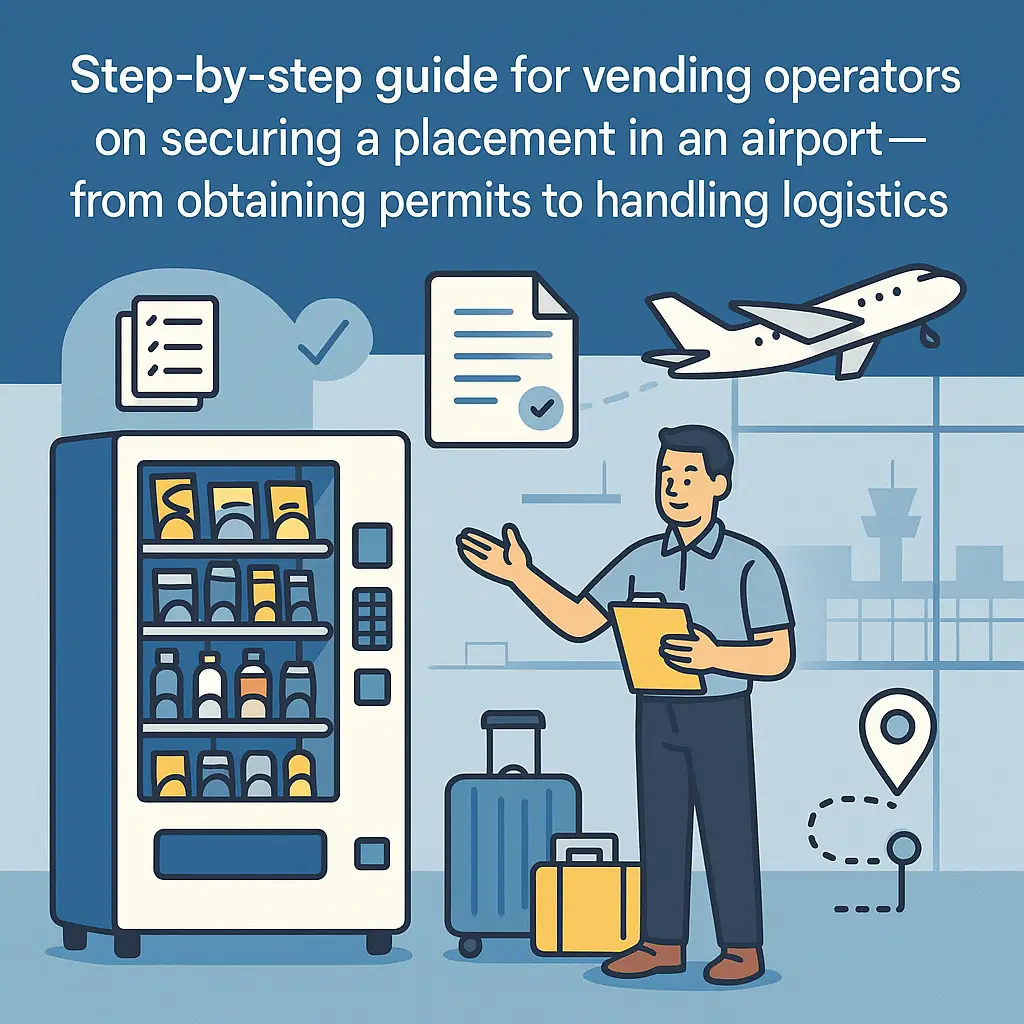How to Place a Vending Machine in an Airport
Step-by-step guide for vending operators on securing a placement in an airport—from obtaining permits to handling logistics.
Back to Vending for Airports ResourcesStep-by-step guide for vending operators on securing a placement in an airport—from obtaining permits to handling logistics.
Back to Vending for Airports ResourcesAirport vending requires compliance with permit regulations, security clearances, and placement guidelines unique to secure terminals.
![]() Permits and approvals are essential for any airport vending location
Permits and approvals are essential for any airport vending location
![]() Security protocols affect placement, delivery, and ongoing operations
Security protocols affect placement, delivery, and ongoing operations
![]() Machine type and product mix must suit high-traffic traveler needs
Machine type and product mix must suit high-traffic traveler needs

Placing a vending machine in an airport involves more than just finding an empty corner. Airports are highly regulated environments with unique logistical, security, and operational challenges. Understanding the process from start to finish can help ensure a smooth and successful placement.
Every airport has its own rules for approving vending machine installations. Before any equipment is ordered, operators must review permit requirements, concessionaire agreements, and placement guidelines. Airports often require background checks for staff involved in installation and servicing. Familiarizing yourself with the application process early prevents costly delays.
For more on regulatory steps, see our guide on security and compliance considerations.
Delivering and installing equipment in secure terminals requires special coordination. Machines must often pass through controlled checkpoints, and installation teams may need temporary security badges. Scheduling deliveries during off-peak hours minimizes disruption. Understanding the airport’s internal logistics is essential to avoid unexpected bottlenecks.
To learn about strategies for smooth operations, check out this detailed overview of airport vending benefits.
Airports serve thousands of travelers daily, so machine selection should match demand. Combo machines offering both snacks and beverages work well in busy concourses. Glass-front machines provide visibility, while micro markets or AI coolers can serve staff-only areas. Stocking items like bottled water, energy drinks, and travel essentials helps meet traveler needs effectively.
For insights on trending technology, explore our article on cashless and multilingual vending solutions.
Once installed, machines must be regularly maintained to meet both airport regulations and traveler expectations. Downtime in high-traffic areas can lead to missed revenue and complaints. Remote monitoring systems can help track stock levels and detect issues quickly. Establishing a maintenance schedule ensures ongoing reliability.
For additional logistical guidance, review our station placement best practices, which share similar operational principles.
If you're exploring vending options for your business, Vending Exchange can help simplify the process. Delivery, Installation and Equipment is provided at no cost to you - vendors provide the machines, keep them stocked, and handle all servicing. Whether you need a provider or full-service management, just fill out the form on this page to get started.
Most airports require vending permits, background checks, and placement approvals through their concessions or facilities department.
Timelines vary by airport, but approvals typically take several weeks due to background checks and security reviews.
Yes, equipment must often pass through security checkpoints, and installation may require escorting or temporary security clearance.
Many airports allow vending in staff lounges or restricted areas, but these placements require additional coordination and approvals.
Top sellers include bottled water, snacks, energy drinks, and travel essentials like phone chargers or hygiene kits.
Yes, tamper-resistant locks, reinforced doors, and cashless payment systems are common security requirements.
Some airports permit micro markets in secure or staff-only areas, depending on available space and compliance with regulations.
High-traffic locations may need daily or multiple weekly restocks to avoid outages, especially during peak travel seasons.
Airports usually require immediate response. Remote monitoring can trigger alerts so technicians can resolve issues quickly.
Yes, many require servicing during off-peak hours or with prior coordination to minimize terminal disruptions.